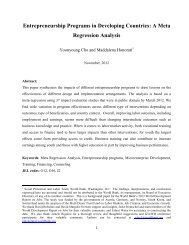Download - Youth Economic Opportunities
Download - Youth Economic Opportunities
Download - Youth Economic Opportunities
Create successful ePaper yourself
Turn your PDF publications into a flip-book with our unique Google optimized e-Paper software.
James Sumberg and Christine Okalisocial relations and obligations—arising, for example, through marriage or childbirth—gavethem additional room to maneuver. There is a sense that young people,and perhaps particularly young men, occupy a social space where the rules arerelaxed, thus giving them additional latitude to experiment and explore.Although we are arguing that social relations must be taken seriously whenboth analyzing opportunity space and promoting individual entrepreneurial activity,we are at the same time forced to recognize the importance of social differencein determining which individuals can make use of particular opportunities. This isespecially important in relation to young men and young women, largely becauseof entrenched views of what is appropriate behavior for one or the other at differentpoints in the transition to adulthood, and the way in which these influence policydesign, implementation, and outcomes.Ideally, we should be seeking to understand the work and income-earningdecisions (of young people, adults, households, and families) in the context of theireconomic and social lives as a whole. This would then shift the focus toward agreater understanding of the interdependency and linked lives of men and women,both within households and families and across generations. While networkapproaches and life-course analyses are well established in the social sciences, todate they have gained little traction in development practice. This kind of approachwould specifically help to highlight the changing ways men and women engage inagriculture, rather than working on the assumption that one size (e.g., professionalizedfarmer) fits all, and at all times. It would also force us to agree that neithertransformation nor empowerment look the same for everyone, nor are they fixedor permanent states.This brings us to the links between transformation and economic empowermenton the one hand and entrepreneurship on the other. What is the theory ofchange supporting entrepreneurship as a key development intervention for ruralyoung people? We suggest that in practice the entrepreneurship agenda is lessabout transformation in the feminist sense of changing structures and power relations(although there are initiatives to engage young people in political processes 17 )and more about the inclusion of rural youth in the current structures and powerrelations. While this might be construed as a staged approach that initially emphasizespromotive over transformative work, there is no indication that this is actuallythe case, or that transformation in the broader sense is even on the agenda.There is a real risk that the rhetoric of transformation and entrepreneurialism(with images of innovation, new opportunities and markets, risk-taking, but aboveall significant job creation—and implying at least the potential for transformation)is being used to mask initiatives that in reality are much less ambitious. Our senseis that many of these are essentially about creating opportunities for self-employmentand petty trade, which may not have much potential to be promotive, to saynothing of transformative. To confuse self-employment and petty trade in theinformal sector with entrepreneurship is not helpful.If this analysis is anywhere near the mark, there are important questions toanswer about the potential nature and scale of the anticipated development impact274 innovations / <strong>Youth</strong> and <strong>Economic</strong> <strong>Opportunities</strong>
















